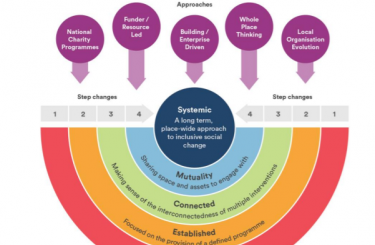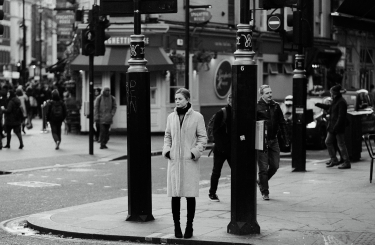What does Participatory Grant Making (PGM) mean to you?
Participatory Grant Making is special because it attempts to disrupt a system. It doesn’t make sense to tackle inequality through an unequal system. We are looking to those who are experiencing inequality to find the solutions.
It is also such an interesting way of doing grant making! It helps us a funder to keep our finger on the pulse, and build relationships with people in our community.
Why is it so important to Camden Giving?
We’ve done PGM since we were set up in 2017. We wanted to devolve power to local residents, as they are the people who face or witness the inequalities first hand in the area they live. We were lucky to have a creative Board, with trustees who wanted us to do things differently. At the time we weren’t doing this consciously as Participatory Grant Making, so when we discovered a term and framework for what we were doing already existed, it gave us faith that it’s a concept that works: there are others who have realised the same thing and come to the same conclusion. It is good to know we are part of a wider community of practice.
Some might see PGM as a more risky way of grant making. Why is this?
People are complicated, and some organisations might see this as a risk but for me it is what enriches our work.
It can be seen as the unknown. Camden Giving have worked this way from its inception and we’ve never recognised the risk. But anything which moves from a more traditional model can be seen as risky. We are working with people whose roles exist outside an institution– opening opportunities to others, and working with complication. People are complicated, and some organisations might see this as a risk but for me it is what enriches our work. We’ve worked successfully with over 100 panellists since 2017, and so far nothing has gone wrong and so we have to challenge others who think this way of working presents more risk.
Can you give us an insight into what your role entails?
My role looks different every day of the week. The main area of focus is recruiting, training and supporting panel members, looking at where they want to go next, and how we can link them to other networks. I also support the operational side of grants – our main focus is accessibility: are we making our application process as accessible as possible?
Our panel co-design all aspects of the funding programmes, from the themes to what questions we should ask in the application form. We try to only ask what is actually useful and accessible to our panels, this in turn has allowed us to reduce the length of our application forms. We spend a lot of time offering one-to-one advice calls to potential applicants; offering support and training throughout the application process. We also offer feedback to all applicants who are unsuccessful. This is quite unusual but as a participatory funder I have been granted permission to spend more time talking to people. If funders want to be more inclusive and accessible, they need to look at who they spend the most time talking to. We’ve decided to prioritise speaking to organisations and applicants who need additional support to navigate the funding ecosystem.
Do you think working in a PGM model has changed who receives funding in Camden?
Risk-taking results in more groups being funded and diversifying the eco system.
Yes. Risk-taking results in more groups being funded and diversifying the eco system. It’s led to more grassroots groups receiving money - partly because of the additional time we spend with first time applicants and un-constitutionalised groups. Panellists won’t be seduced by well worded applications. They are encouraged to use their instincts and go on the idea, not the way it has been written.
As well as who gets the money it’s helped us better understand our community, what’s changing in Camden and the growing inequalities. This is what convinces you – the real value of working with local people. They will keep you ahead of the curve. Their conversations are much more revealing about the intersectionality of the issues. For example, our youth panel have been telling us about the links between racism and school exclusion. It helps us see the relationships between different issues which we can then take across when thinking about our programme and how we can design this differently. This isn’t to say our panels don’t fund larger, more traditional organisations – but sometimes these organisations receive feedback from our panellists on how to be agile in a constantly changing landscape.
Has it changed the relationship you have with your donors?
It has strengthened our partnerships with Camden Council. We invite them to meetings, so they hear directly about issues faced by local people. It shapes their programmes.
With corporate supporters, there is a real need to connect to the community where they are based so that they are not perceived as being in an ‘ivory tower’ in the local area. So we connect them to local charities. We like to bring people along the journey with us, so we’ll invite donors to meet panellists, to see the journey in person – like a more human interim report, hearing the stories directly from residents they would otherwise not have met.
Has PGM brought about wider benefits to you as an organisation?
Camden Giving created a manifesto rather than a business plan, as we felt this was more in the spirit of PGM. We’ve changed what we want to measure. If we are recruiting 50 community panellists, how many then go on to other opportunities, or are supported into work? We try to look at the wider impact, and the longer term relationships built.
We are trying to make our evaluation as participatory as possible. For example we are holding learning sessions over the year and inviting our grantees to tell stories, and thinking how we can shift the way we capture our learning. We are also helping to convene a community of practice as part of a global participatory grant making network established by Hannah Paterson of the National Lottery Community Fund. This is just the beginning of the journey for us, we need to be ever evolving. We have not figured out the best way of doing it, it relies on constant redesign.
What would you say are the essential elements for meaningful participatory grant making?
Challenge yourselves and think ‘what do we want to do, is this the right time?’
Firstly, it’s designing the process for people, and not assuming people can flourish in current way of working.
Understanding the purpose is key. For us it’s about attracting diverse voices and not defaulting to status quo. The beauty of PGM is that there are lots of versions of it – no one size fits all. Figure out what you want to do or why you want to do it. If you’re not quite ready to fully change your way of working, trial it, do it with one grant programme. But it is important to be clear if what you want to do is participatory or advisory – just adding one or two people with lived experience in a room won’t achieve a radical shift in power and could even be more damaging. Challenge yourselves and think ‘what do we want to do, is this the right time?’ You don’t want to replicate oppressive behaviours we are trying to move away from.
Be iterative – our process has changed a lot since 2017, we are constantly asking for feedback from our community panellists and grantees, and making improvements to the process.
Resource it properly so you can pay people for their knowledge and expertise. Work out how to pay people around their benefits. Speak to a benefits expert, as this can be minefield.
London’s Giving movement celebrates the value of place based funding. Do you think PGM is a particular fit to the ethos of the Giving movement, and why is this?
If we are looking at inequality in place, it makes sense to work with the people working in and benefiting from the area. Camden is a tale of two cities – we have the headquarters of large multinational corporations next to extreme poverty. Childhood poverty is up to 43% since covid. Place-based giving puts a lens on the real issues in one locality: it makes it possible to tackle inequalities in once place. But it is also good to do PBGS in a participatory way as it is all about the relationships. We couldn’t just do this in isolation from other partners in Camden. A huge benefit of being place-based is that this is possible. It’s helped make Camden a borough of collaboration.
What reflections have you taken from the last year about PGM?
We think it’s the perfect time to take risks and devolve power to community members.
With the pandemic, some funders defaulted to traditional ways of working to deliver emergency funding. Perhaps they saw it as too complicated and too risky during an already challenging time. Despite the challenges, we were able to recruit seven community members within 24 hours for our emergency covid panel, and who have been fully committed during 3 rounds of our Covid-19 Emergency Fund. This was made possible because of the relationships we already have, but we think it’s the perfect time to take risks and devolve power to community members and would encourage other funders to experiment with the PGM model if they’ve been thinking about it.
At the beginning of the first lockdown, we committed to a tagline: what’s possible not perfect. We’ve started from here and gone from strength to strength. Working at Camden Giving and having an interactive, collaborative approach allows us to collectively learn, experiment and try things. I would say lean into the complication and experiment. It will definitely enrich your organisation.

